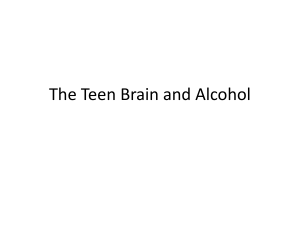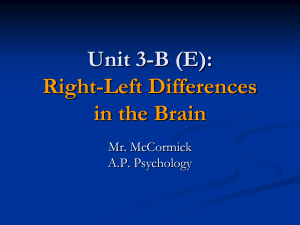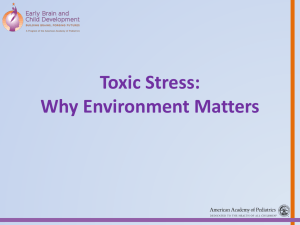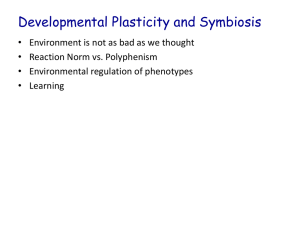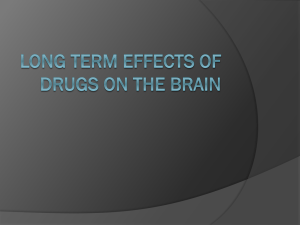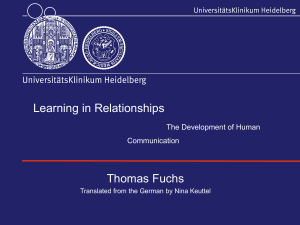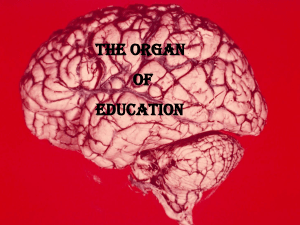Brain plasticity power point
advertisement
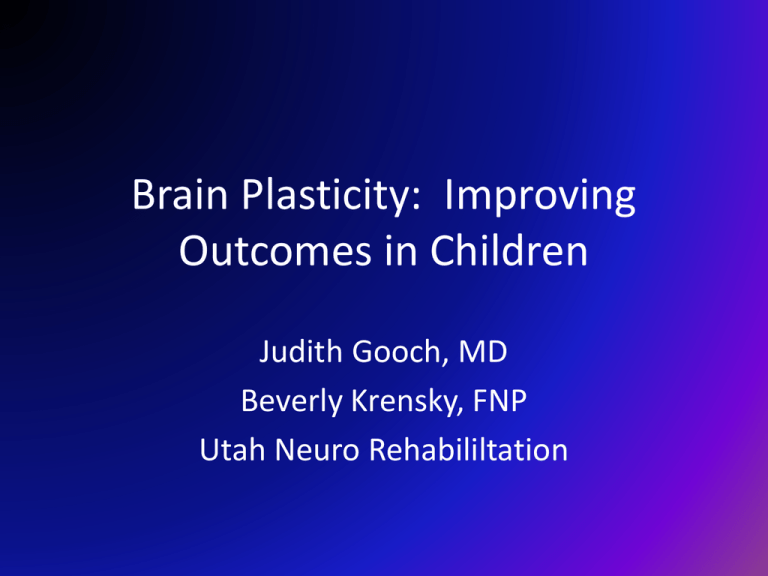
Brain Plasticity: Improving Outcomes in Children Judith Gooch, MD Beverly Krensky, FNP Utah Neuro Rehabililtation Objectives • • • • Discuss the concept of brain plasticity Show how plasticity depends upon activity Discuss the mechanisms for brain plasticity List techniques to improve outcomes using brain plasticity Outline • • • • • • • • Brain plasticity definition Study of plasticity Examples of plasticity Aging and plasticity Brain injury and plasticity Mechanisms of plasticity Techniques to improve outcomes Practical ideas Brain Plasticity • The brain's ability to reorganize by changing neural pathways and synapses. • A result of changes in behavior and environment as well as changes resulting from injury. • Allows the brain to compensate for injury and disease and to adjust in response to new situations or to changes in environment. Brain Plasticity • A property of the nervous system retained throughout life • The mechanism for learning, growth and development • The result of each motor act and sensory input Why should we care about brain plasticity? • • • • • . Promote learning in children Improve function after brain injury Overcome difficult childhood experiences Learn new sports Prevent cognitive decline as we age How do we Study Plasticity? • • Animals: electrical stimulation and microscopic assessment • Humans: functional MRI and PET scans assess changes in brain metabolism with specific tasks Evolution of Understanding: Brain Function • • • • Localization of function Questioning of localization Possibility of brain plasticity Understanding of brain plasticity Brain Localization • Paul Broca, 1861 had a patient who had lost language skills due to a stroke • Dissection showed damage to a specific area in the left frontal lobe. • Carl Wernicke showed damage in the left temporal lobe lead to inability to understand language Questioning Localization • Jules Cotard (1868) studied children with early massive brain disease with loss of left hemisphere. • The children could still speak. Questioning Localization: Paul Bach-y-Rita, MD • Introduced sensory substitution for patients with neurological disorders. • Accelerometers on patients with vestibular injuries linked to a computer. Information fed to a small plate on the tongue. Stimulates different areas of the tongue, depending on the orientation of the accelerometers.[ Significantly improves balance. Examples of Brain Plasticity Increased Cortical Representation of the Fingers of the Left Hand in String Players • Reports • Brain representation of left hand fingers of string players larger than in controls • No differences for right hand • Amount of brain representation correlated with the age at which the person started playing • The representation of different parts of the body in the sensory part of the brain depends on use and changes as a result of the needs and experiences of the person Neuroplasticity in Braille Readers: Alvaro Pascual-Leone, MD, PhD • Blocked the visual cortex of Braille readers using magnetic stimulation • Subjects could not read Braille or feel with Braille reading finger • Visual cortex was used for information on touch Navigation-related structural change in the hippocampi of taxi drivers • Brain MRI’s of London taxi drivers compared with controls • The hippocampi of taxi drivers significantly larger than those of controls • Hippocampal size correlated with the amount of time spent as a taxi driver • The hippocampus stores spatial information and can expand in people who depend upon navigational skills. Constraint-Induced Therapy in Stroke: Edward Taub, MD • CI therapy group: intensive training for 6 hours per day for 2 weeks, restraint of the less affected extremity for 90% of waking hours • Placebo group: program of physical fitness, cognitive, and relaxation exercises • After CI therapy, patients had improvements in functional use of affected arm. • Changes persisted for 2 years. • Placebo subjects showed no significant changes. Anatomical Plasticity Evidence: Mark Rosenzweig, PhD • Changes in brain anatomy and chemistry have been shown in young and non-injured rats by changing the environment. Rats raised under "enriched" conditions had greater cortical weight, total acetylcholinesterase activity and cortical depth than their "impoverished environment" littermates. Scores on a maze test were also better. Plasticity is a result of activity and environmental stimulation Plasticity: Use it or Lose it Michael Merzenich, PhD • • • • • Mapped a monkey’s hand map in the brain Amputated the middle finger Remapped the brain months later Brain map for amputated finger disappeared Maps for adjacent fingers took over space of middle finger Aging and Brain Plasticity Neuroplasticity in old age: induction of hippocampal neurogenesis by long-term environmental enrichment • Formation of new cells in the hippocampus declines with age. • New cell formation in mice living in an enriched environment five times greater than in controls. • Improvements of learning, exploratory behavior, and locomotion. • Enriched living mice had molecular evidence of less agedependent degeneration. Video game training enhances cognitive control in older adults • Multitasking declines with age. • By playing a race car videogame, 60 to 85 year olds improved multitasking compared to a control group. • Attained levels beyond those achieved by untrained 20-year-olds. • Enhanced sustained attention and working memory. • Findings show robust plasticity of the cognitive control system in the aging brain. The Dark Side of Plasticity: (The Brain that Changes Itself Norman Doidge, MD) • Plasticity paradox • Neuroplastic processes which allow us to change our brains and be flexible can also promote rigidity • Repeated times down a hill on a sled creates a pathway Brain Plasticity and Culture (Bruce Wexler) • Plasticity declines with age • Becomes more difficult to change in response to the world • Familiar types of stimulation are pleasurable • Seek out like-minded people • Individuals attempt to make the environment conform to the internal structures of the brain • Cultural groups try to impose their views on other cultures Brain Injury and Plasticity • Brain injury itself leads to plastic changes • Activity and environmental stimulation impact these changes Recovery after Brain Injury • With recovery, there is increased activation of uninjured cerebellum, motor cortex, and sensory cortex on both sides. • Human and animal studies show that postinjury experience has major impact on changes in the undamaged tissue. Recovery after Brain Injury Functional improvement after injury is a relearning process Patients must work to re-acquire the ability to produce behaviors lost after injury Compensation vs. Recovery • Compensation with different behaviors after injury • Compensation may limit recovery of impairment Mechanisms of Brain Plasticity Mechanisms of Brain Plasticity • • • • • Dendritic branching Young cells are stimulated after injury Axonal sprouting Gene regulation Decrease of inhibition Mechanisms of Brain Plasticity: Activity and Inhibitors • Adult CNS has an inhibitory milieu to axonal sprouting • Activity allows neurons to become insensitive to growth inhibitors • Activity increases growth promoting molecules License to run: exercise impacts functional plasticity in the intact and injured central nervous system by using neurotrophins • • • • Exercise impacts molecular systems that effect brain plasticity. Exercise increases brain-derived neurotrophic factor (BDNF). BDNF increases synaptic function and neuron excitability. Exercise can promote neuron repair and enhance learning and memory Mechanisms of Brain Plasticity: Improving efficiency • Monkeys touched with finger tip a spinning disc with a specific pressure for a specific time • Brain map for finger tip enlarged as they learned task • As they improved, fewer neurons needed Mechanisms of Brain Plasticity: Normal development and learning y: • Early over-production of synaptic connections • Followed by a substantial decrease in the number of synapses over time • Information is stored by selecting useful connections and pruning back surplus connections. • Learning new tasks can add new neural connections Plasticity and Learning: Eric Kandel (Nobel Prize winning learning theorist) • Short-term memory is linked to functional changes in existing synapses • Long-term memory is associated with a change in the number of synaptic connections. Using Brain Plasticity to Improve Outcomes • For our patients • For ourselves • Focus on motor function in children with disabilities • Principles apply to cognitive and emotional function Activity to Promote Brain Plasticity • PLASTICITY DEPENDS UPON ACTIVITY • Motor learning theory provides a framework for optimizing learning through activity taking advantage of plasticity Motor Learning Theory The most effective way to learn a task is to practice on a daily basis in the home and community setting. Motor Learning: Practice • • • • PRACTICE A LOT Practice variable tasks Take rest periods Solve problems through trial and error, don’t just repeat simple tasks over and over Other Motor Learning Strategies • Provide feedback • Motivate with functional goals • Promote attention Attention is Necessary for Plasticity • Lasting changes in brain maps occurred only when monkeys paid close attention to the task • When tasks were performed automatically, changes in brain maps did not last Attention: Effects of Drugs on Plasticity in Brain Injury • • Drugs enhancing norepinephrine and dopamine have consistently been shown to accelerate recovery from brain injury. • Stimulant medications Effects of Drugs on Plasticity in Brain Injury • Cats and rats with brain injury who were given stimulants combined with “physical therapy” (forced beam walking) recovered motor function more quickly and more completely than controls. Other Techniques to assist learning after brain Injury • EMG-triggered muscle stimulation: Movement is initiated by patient and facilitated with electrical stimulation. • Robotic therapy: Patient attempts a movement. Robot assists with completion of the movement, increasing sensory input and motivation. Practical Application • Teach families that their daily interactions are the most important therapy • Motivate to provide regular brief periods of stimulation • Show how to integrate this stimulation into daily routine Practice skills in a fun and practical manner. • • • • • • • Put dishes in the dishwasher Play with balls Brush teeth Play games Play with play dough Ride a trike Play an instrument Practical Application • Involve kids in recreational activities • Many adaptive programs available Other Suggestions • Explore and educate about techniques and therapies in the community • Put families in contact with other families Activity to Promote Plasticity in Us • • • • • Be active Learn Exercise Keep an open mind Play videogames
